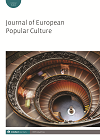- Home
- A-Z Publications
- Journal of European Popular Culture
- Previous Issues
- Volume 11, Issue 1, 2020
Journal of European Popular Culture - Volume 11, Issue 1, 2020
Volume 11, Issue 1, 2020
- Editorial
-
- Articles
-
-
-
Ruined intimacy and intimate ruins in Andrey Zvyagintsev’s Loveless (2017)
More LessThe collapse of the Soviet Union, followed by a period of cultural disorientation, and ensuing the rise of unfettered capitalism, offers scholars a conceptual magnifying glass with which to understand radical social change. Contemporary Russian popular culture, emerging in this unique social context, becomes a privileged venue to scrutinize the nature and implications of radical change. This article explores the transformations of intimacy through the lens of Andrey Zvyagintsev’s latest feature film Loveless (2017). This film captures a profound disruption of intimacy in compliance with market principles, technology and social media. Zvyagintsev juxtaposes instances of ruined intimacy with spaces of intimate physical ruins. The article suggests that the cinematic visual meditation on ruins and ruination implicates a more expansive meditation on the transient and permanent aspects of our lives, the intersection between nature and culture, as well as the play between presence and absence. By drawing on Aronson’s (2015) cross-cultural work on emotional frameworks, this article argues that Loveless (2017) shows how Aronson’s regime of (rational) choice colonizes the regime of (passionate) faith, with deleterious consequences.
-
-
-
-
Diversity and democratization of Dior in Australia: Social factors in fashion modification in the 1940s–50s
More LessChristian Dior’s 1947 ‘New Look’ collection has been widely examined for its influence on both haute couture and clothing styles in the 1950s. In the Australian context, Margaret Maynard examined how the New Look was marketed through the ideological positioning of women’s roles in the domestic sphere. This marketing campaign was spearheaded by two business syndicates who brought a series of French Fashion Parades to Australia in the late 1940s through the 1950s. Despite the hype around the parades, just how much the fashions were adopted by the wider public has not been measured. Australians did not adopt the New Look unchanged, instead local sensibilities, climate and culture meant modification was inevitable.
Through examining home-sewing patterns, photographs of key cultural events and images from popular magazines from the period, this article establishes how the New Look was modified in the Australia. Results show that despite the many women who were eager to embrace the new fashion, many more were reticent, clinging in particular to the shorter hemlines they had adopted during the war years. This led to a hybrid style that both followed the French lead and suited Australian society. French designers, keen to expand their business empires through licensing, responded to these adaptions, incorporating elements into their later collections. This represented a step away from the trickle-down model. This changing dynamic gave Australian customers the confidence to demand more from the fashion designers and to adapt fashion to suit the Australian context. By examining the impact of Dior’s New Look through the lens of ordinary Australian women, the influences of both the designer and his customers on the evolution of post-Second War World are exposed.
-
-
-
Punk aesthetics of Pedro Almodóvar’s Pepi, Luci, Bom: Self-reflexivity, subcultural formations and queer temporalities
More LessTracing the direct and indirect influences and cultural connections between earlier counter-cultures and avant-garde art has been a useful method to historicize the aesthetics that is created by subcultures. Drawing from this approach, this article seeks to contribute to the study of the aesthetics and counter-cultures via analysing a specific cinematic self-reflexivity that is born out of the interconnectedness of low-budget material conditions and the subcultural environments. The contention is that Pedro Almodóvar’s first feature film Pepi, Luci, Bom y otras chicas del montón (1980), embodies such punk aesthetics and queer temporalities, through the temporary disruptions in narrative progression, the abundance of queer parody, the combination of camp, TV ads, musical performance and the non-diegetic insertions of comic book-style textuality. In this collage, the politics of realistic representation are thrown out of the picture via a deliberate coupling of artificiality and spontaneity. This article argues that the embeddedness of Pepi, Luci, Bom in Madrid’s subcultural movement, la movida madrileña, demonstrates perfectly how subcultural experience gives way to an aesthetic coping mechanism that transforms low-budget restrictions into self-reflexivity. The disparate narrative vantage points in the film that rupture linearity and how the subcultural environment prompted disruptive entrances through which the film’s satire emerged are taken as critical-aesthetic offerings of queer temporalities that exude through the experiential knowledge of exclusion and oppression.
-
- Interview
-
- Book Reviews
-
-
-
Youth and Popular Culture in 1950s Ireland, Eleanor O’Leary (2018)
More LessBy Marcus FreeReview of: Youth and Popular Culture in 1950s Ireland, Eleanor O’Leary (2018)
London: Bloomsbury Academic, 240 pp.,
ISBN 978-1-35001-589-0, h/bk, £85.00
A Post-Nationalist History of Television in Ireland, Edward Brennan (2019)
Basingstoke: Palgrave Macmillan, 231 pp.,
ISBN 978-3-31996-859-9, h/bk, €72.79
-
-
-
-
Fairytale and Gothic Horror: Uncanny Transformations in Film, Laura Hubner (2018)
More LessReview of: Fairytale and Gothic Horror: Uncanny Transformations in Film, Laura Hubner (2018)
London: Palgrave Macmillan, 206 pp.,
ISBN 978-1-137-39346-3, h/bk, €96.29
-
-
-
Planet Cosplay: Costume Play, Identity and Global Fandom, Paul Mountfort, Anne Peirson-Smith and Adam Geczy (2019)
More LessBy Liam BurkeReview of: Planet Cosplay: Costume Play, Identity and Global Fandom, Paul Mountfort, Anne Peirson-Smith and Adam Geczy (2019)
Bristol, UK: Intellect, 308 pp.,
ISBN 978-1-78938-151-1, p/bk, £37.00, ISBN 978-1-78320-956-9, h/bk, £72.00
-
-
-
Personal Style Blogs: Appearances That Fascinate, Rosie Findlay (2017)
More LessReview of: Personal Style Blogs: Appearances That Fascinate, Rosie Findlay (2017)
UK: Intellect, 199 pp.,
ISBN 978-1-78320-834-0, p/bk, £25
-
-
-
The Road to Grantchester, James Runcie (2019)
More LessBy Tom UeReview of: The Road to Grantchester, James Runcie (2019)
New York: Bloomsbury, 336 pp.,
ISBN 978-1-63557-058-8, h/bk, $28, ISBN 978-1-63557-394-7, p/bk, $17
-
Most Read This Month


